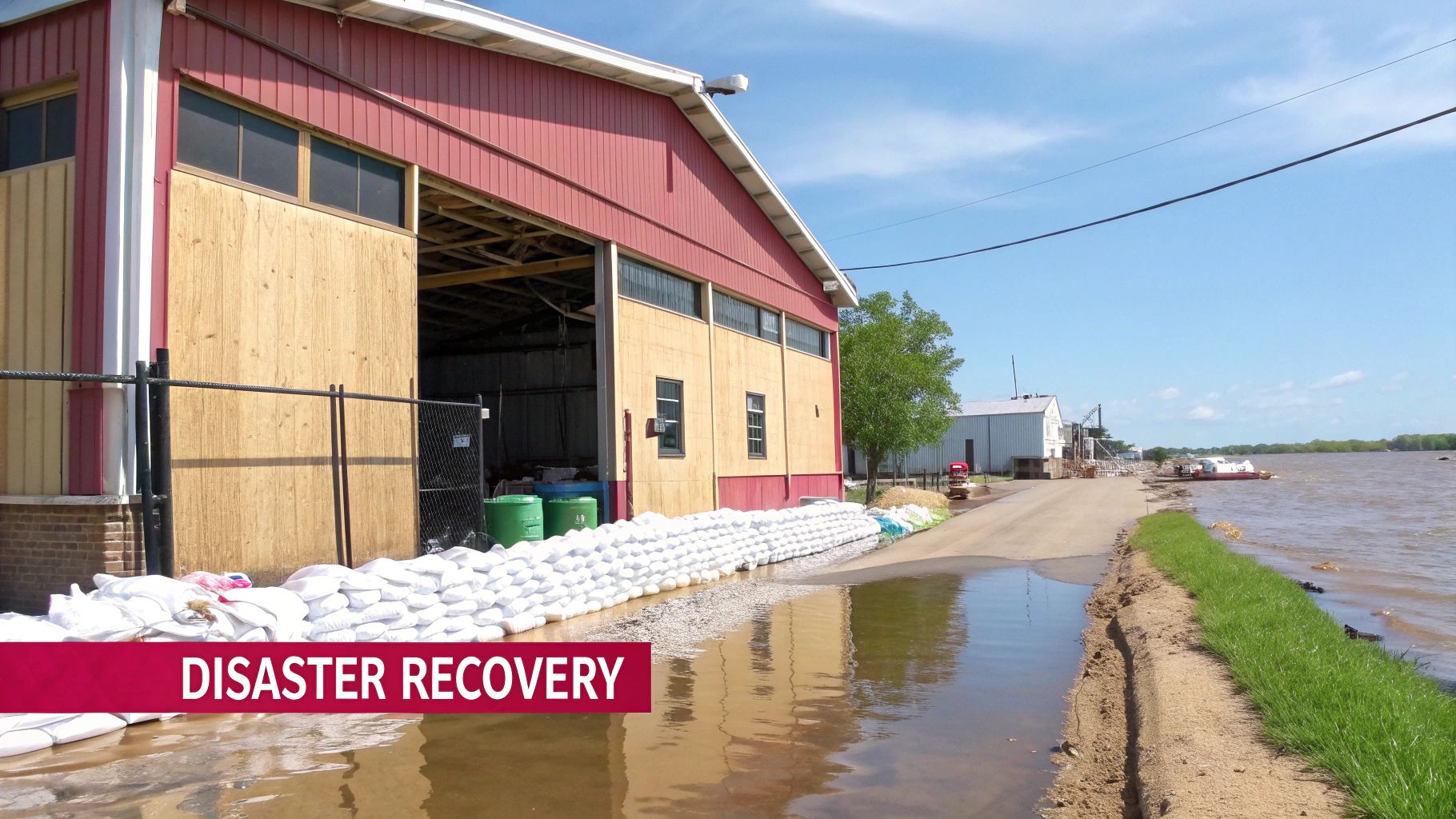Explore essential business continuity plan examples to safeguard your UK firm. Learn practical strategies for 2025 and ensure resilience today.

In today's unpredictable landscape, a theoretical business continuity plan is no longer sufficient. From cyber-attacks to supply chain shocks, UK businesses, particularly those in professional services, face a myriad of threats that can halt operations in an instant. The key to organisational resilience lies in practical, actionable planning grounded in real-world scenarios. This guide moves beyond abstract concepts to provide concrete business continuity plan examples, offering detailed frameworks you can readily adapt for your own operations.
We will dissect what makes these plans effective, covering everything from pandemic response protocols to robust IT infrastructure recovery strategies. The goal is to provide strategic insights and tactical steps to help you build a truly robust defence for your organisation. For businesses across Dorset, Somerset, Wiltshire, and Hampshire, translating these examples into a customised, managed strategy is critical. A local partner can be instrumental in implementing and managing these complex plans, ensuring your operations remain secure and continuous, no matter the disruption. This article will show you not just what to plan for, but how to construct a plan that works when you need it most.
A pandemic business continuity plan is a specialised framework designed to maintain essential operations during widespread public health crises. Unlike generic disaster plans that focus on short-term physical disruptions, this plan addresses prolonged challenges like mandated remote work, significant employee absence, supply chain breakdowns, and evolving health and safety protocols. It is a critical component of modern resilience planning, as demonstrated during the COVID-19 pandemic.

The core of this plan is enabling operational flexibility. It moves beyond simple IT backup to encompass human resources, logistics, and communications, ensuring the business can adapt to changing government guidance and public health realities over months or even years.
Microsoft's transition of over 160,000 employees to remote work nearly overnight showcased the power of a pre-existing, cloud-first infrastructure. Their success was not accidental; it was built on years of investment in tools like Microsoft Teams and a culture that was already familiar with flexible working. This highlights a key strategic point: pandemic readiness is a long-term investment, not a last-minute reaction.
A practical example for a professional services firm, such as a large law firm, would be seeing a significant portion of its litigation team fall ill. A robust plan would enable seamless handover of case files to a designated backup team, using secure, cloud-based case management software to ensure deadlines are met and client representation is uninterrupted.
To build one of the most effective business continuity plan examples for a pandemic, professional services firms in regions like Dorset and Hampshire should focus on these replicable strategies:
A cybersecurity incident response plan is a structured approach for preparing for, detecting, responding to, and recovering from information security incidents. This framework is not just an IT checklist; it is a comprehensive organisational strategy involving legal, communications, and management teams. Its purpose is to minimise damage from events like data breaches or ransomware attacks, ensuring a swift and coordinated return to secure operations.
This plan moves a business from a reactive state of panic to a proactive state of control. By defining roles, responsibilities, and clear procedures before an incident occurs, it reduces recovery time, limits financial and reputational harm, and ensures regulatory compliance.
Maersk's recovery from the 2017 NotPetya ransomware attack, which crippled its global operations and cost an estimated £235 million, is a powerful case study. Their recovery was only possible because a single domain controller in a remote Ghanaian office happened to be offline during the attack. This single point of failure-turned-saviour highlights the critical importance of having truly offline, air-gapped backups as a last line of defence.
For a professional services firm, such as a consulting business, a practical example involves a phishing attack that compromises a senior partner's email account. The incident response plan would be immediately activated: the IT team isolates the account, legal counsel is engaged to assess potential data breach notification requirements under GDPR, and a pre-defined communication is sent to clients who may have received fraudulent emails.
To develop one of the most effective business continuity plan examples for a cybersecurity incident, businesses in Dorset, Hampshire, and the surrounding regions should implement these key strategies:
A natural disaster recovery plan is a comprehensive strategy for maintaining operations and recovering quickly from location-specific events like floods, storms, or fires. Unlike a pandemic plan that addresses widespread, non-physical disruption, this framework focuses on protecting physical assets, ensuring employee safety, and re-establishing operations when a primary business location is compromised or inaccessible.

The emphasis of this plan is on resilience against physical damage. It details procedures for everything from facility protection and data backup to activating alternative work locations and managing communications when normal infrastructure fails. It is a fundamental part of any robust business continuity strategy, especially for organisations with significant physical premises.
Walt Disney World's hurricane preparedness is a masterclass in operational readiness. Their protocols are so effective that they can close down the entire resort, secure assets, and communicate with thousands of staff and guests in under 12 hours. This is not just about boarding up windows; it involves pre-arranged supply chains, on-site "ride-out" teams, and detailed, role-specific action lists. This highlights the value of deep, procedural planning and extensive training.
A practical example for a professional services firm, like an architectural practice in a flood-prone area, would involve having all project blueprints and client files stored on a secure cloud platform. If the office is flooded, architects can continue working from a pre-arranged alternative site or home, accessing all necessary data immediately and preventing costly project delays.
To develop one of the most effective business continuity plan examples for a natural disaster, professional firms in counties like Dorset and Hampshire, which are susceptible to flooding and severe storms, should prioritise these strategies:
A supply chain disruption plan is a strategic framework designed to maintain operations when the flow of goods, materials, or services is interrupted. For a professional services firm, the "supply chain" often includes critical third-party software vendors, outsourced administrative functions, or specialist consultants. The plan addresses vulnerabilities from various sources, including supplier failure, geopolitical instability, or technology outages. Its primary goal is to ensure service availability and minimise operational impact.

The essence of this plan is shifting from a purely cost-optimised model to a more robust "just-in-case" approach. It requires a deep understanding of every critical vendor and service provider to identify and mitigate potential points of failure before they cause a crisis.
Toyota's response to the 2011 Japanese earthquake is a masterclass in supply chain resilience. Having learned from previous disruptions, Toyota had meticulously mapped its multi-tiered supply network. This detailed visibility allowed them to quickly identify which specific sub-suppliers were affected and collaborate directly to restore production far faster than competitors. This proves that resilience is built on deep supplier relationships and granular data.
For a professional services firm like a marketing agency, a practical example of a supply chain disruption is its primary video production partner suddenly going out of business. A good plan would mean the agency has already vetted and established relationships with two alternative production houses, allowing them to re-assign a client's project within 24 hours with minimal disruption to the campaign timeline.
To develop one of the most effective business continuity plan examples for supply chain resilience, professional services firms and SMEs in Hampshire and Dorset should consider these strategies:
A Data Centre and IT Infrastructure Plan is a technical framework dedicated to guaranteeing the continuous operation of critical IT systems. This specialised business continuity plan focuses on mitigating risks from hardware failures, power outages, network disruptions, and physical facility damage. It employs strategies like redundancy, robust backup systems, and documented disaster recovery procedures to protect the digital core of a modern business.
This plan is foundational for any organisation reliant on digital information, which, in today's world, is nearly every business. It ensures that even if a primary server fails or a data centre experiences a blackout, core services like client databases, financial applications, and communication platforms remain accessible and functional, preventing catastrophic data loss and operational downtime.
The architecture of major cloud providers like Amazon Web Services (AWS) and Microsoft Azure offers a masterclass in IT resilience. Their use of Availability Zones (AZs) — distinct data centres within a region with independent power, cooling, and networking — is a core strategic principle. If one entire facility goes offline due to a localised incident like a fire or flood, operations are automatically failed over to another AZ in the same region, often with no noticeable impact on the end user.
This distributed model demonstrates that resilience is not just about having a backup; it is about architectural design. A practical example for a professional services business, such as an engineering firm, is using a cloud-based CAD and project management system. If their local office network goes down, engineers can still access and work on complex design files from any location with an internet connection, ensuring project milestones are not missed.
For businesses in regions like Somerset and Wiltshire, achieving this level of resilience is highly accessible through cloud services and smart planning. These replicable strategies form the core of one of the most effective business continuity plan examples for IT infrastructure:
A financial crisis management plan is a strategic framework for navigating severe economic turbulence. This type of plan prepares a business to maintain essential operations during market crashes, recessions, banking crises, or a sudden, catastrophic loss of a major client. Its primary focus is on financial resilience, emphasising meticulous cash flow management, strategic cost reduction, and the protection of core business functions with potentially diminished resources.
This plan moves beyond standard financial forecasting to create a defensive playbook. It is designed to be activated when economic indicators turn negative, allowing a business to act decisively rather than reactively, preserving capital and stabilising the organisation until market conditions improve.
Southwest Airlines’ performance during the 2008 financial crisis is a masterclass in financial preparedness. While other airlines were burdened with debt and complex fleets, Southwest maintained a strong balance sheet and a simplified, single-aircraft model (Boeing 737). This drastically reduced maintenance and training costs, giving them a crucial operational advantage. Their strategy shows that long-term financial discipline is the bedrock of crisis resilience.
For a professional services firm, such as a medium-sized accountancy practice, a practical example involves creating a tiered cost-reduction plan. Tier 1 (triggered by a 15% revenue drop) might involve freezing non-essential hiring and travel. Tier 2 (triggered by a 30% drop) could activate pre-negotiated flexible payment terms with landlords and software vendors, preserving cash flow without immediately cutting staff.
To develop one of the most effective business continuity plan examples for a financial downturn, service-based businesses in Dorset and Hampshire should integrate these strategies:
A key personnel succession plan is a strategic framework designed to ensure operational continuity when vital employees are unexpectedly lost, whether through illness, resignation, or retirement. It goes beyond a simple replacement strategy by proactively identifying critical roles, nurturing internal talent to fill them, and systematically transferring crucial institutional knowledge. This plan is a core element of organisational resilience, preventing the disruption that occurs when a business is over-reliant on a single individual.
This type of plan ensures that essential leadership functions and specialised skills are not lost, safeguarding long-term stability and performance. It involves a continuous cycle of talent assessment, development, and knowledge management, making the organisation more agile and less vulnerable to personnel-related shocks.
General Electric (GE) has long been regarded as a gold standard in leadership development and succession planning. Their rigorous, multi-year process involves identifying high-potential employees early, rotating them through diverse roles and business units, and providing continuous mentorship from senior leaders. This is not just about finding a new CEO; it is a deeply embedded cultural practice that creates a pipeline of ready leaders at every level.
A practical example for a professional services firm is a small wealth management advisory where one senior advisor manages the firm's largest client portfolios. The succession plan would involve a junior advisor shadowing the senior for two years, being systematically introduced to clients, and co-managing the portfolios. This ensures a seamless, trust-based handover if the senior partner retires, preventing client attrition.
To build one of the most effective business continuity plan examples focused on succession, professional services firms in Dorset and Hampshire should integrate these replicable strategies:
A communication crisis management plan is a vital component of business continuity, designed to control the narrative and maintain stakeholder trust during a significant disruption. It goes beyond simple public relations to establish a strategic framework for all internal and external messaging. This ensures information is accurate, consistent, and timely, preventing misinformation from compounding the initial crisis.
This plan is not just for large-scale disasters; it is activated for any event that could harm the company's reputation, from data breaches to service outages or negative press. A well-executed communication plan can be the difference between a swift recovery and long-term brand damage, making it one of the most critical business continuity plan examples for any organisation.
Johnson & Johnson's response to the 1982 Tylenol crisis remains a gold standard in crisis communication. When capsules were found to be laced with cyanide, the company immediately pulled all 31 million bottles from shelves nationwide, a move costing over $100 million. They communicated transparently with the public, prioritising consumer safety over profits. This decisive, ethical action allowed Tylenol to not only recover but to recapture and grow its market share.
A practical professional services example would be an IT consultancy firm experiencing a major outage of its client-facing support portal. The communication plan would immediately trigger: a pre-written message is posted to social media channels acknowledging the issue, account managers personally call their largest clients to provide direct updates, and a status page is launched to provide real-time ETAs for resolution. This proactive communication prevents client frustration and speculation.
To develop a robust communication plan, professional services firms across the UK, from solicitors in Somerset to accountants in Wiltshire, should adopt these core strategies:
Plan TitleImplementation ComplexityResource RequirementsExpected OutcomesIdeal Use CasesKey AdvantagesPandemic Business Continuity PlanHigh (tech investment & coordination)Significant tech & training costsMaintain operations & employee safetyWidespread health emergencies like pandemicsBusiness survival; employee protection; client retentionCybersecurity Incident Response PlanHigh (specialised expertise needed)Cybersecurity tools & skilled teamMinimised damage and downtimeCyber attacks such as breaches, ransomwareDamage control; regulatory compliance; trust maintenanceNatural Disaster Recovery PlanHigh (infrastructure & coordination)Facility upgrades & backup sitesProtect assets & ensure quick recoveryNatural disasters like hurricanes, floodsAsset protection; safety; minimised interruptionSupply Chain Disruption PlanMedium to high (complex supplier management)Supplier management & inventoryContinuity of service & reduced disruptionsSupply chain interruptions due to varied causesReduces supplier risk; maintains service availabilityData Centre and IT Infrastructure PlanVery high (technical & infrastructure intensive)High-cost infrastructure & expertiseHigh system availability & minimal downtimeIT system failures, power/network outagesData protection; operational continuity; uptimeFinancial Crisis Management PlanMedium (financial planning & analysis)Cash reserves, financial expertiseBusiness viability during economic crisesEconomic downturns, market crashesPreserves viability; stakeholder confidence; quick decisionsKey Personnel Succession PlanMedium (planning & training intensive)Training & knowledge managementSmooth leadership & operational transitionsLoss of key employees unexpectedlyReduces dependency; knowledge retention; smooth transitionsCommunication Crisis Management PlanMedium (communication resources needed)Communication team & monitoring toolsMaintained reputation & stakeholder trustPublic relations crises, sudden disruptionsBrand protection; consistent messaging; misinformation control
Throughout this article, we have dissected eight distinct business continuity plan examples, moving beyond generic templates to provide a strategic blueprint for true operational resilience. From navigating the complexities of a supply chain disruption to executing a flawless cybersecurity incident response, the core lesson remains consistent: a robust plan is proactive, not reactive. It is a living document, deeply integrated into the very fabric of your organisation's culture and technological infrastructure.
We have seen how a Wiltshire-based accountancy firm must prioritise data integrity and client communication in a financial crisis, while a care provider in Somerset needs a plan that guarantees continuity of care and protects vulnerable individuals during a natural disaster. The common thread connecting these diverse scenarios is the critical role of a well-defined, regularly tested, and technologically sound strategy. Simply having a plan filed away is insufficient; true resilience is achieved when that plan is an active, dynamic component of your daily operations.
The examples provided highlight several universal truths for any business, particularly professional services firms in Dorset and Hampshire:
Ultimately, crafting and maintaining these intricate plans is a significant undertaking. The most effective business continuity plan examples are not just documents; they are managed, tested, and refined through an ongoing partnership. This journey from a static plan to a dynamic state of readiness is where specialist expertise becomes invaluable. For small and medium-sized businesses, dedicating internal resources to this constant cycle of testing, updating, and technological alignment can be overwhelming and divert focus from core activities. Partnering with an expert team ensures your plan evolves with emerging threats and technologies, transforming it from a theoretical exercise into a guaranteed defence for your business's future.
Is your business prepared for the unexpected? Do not let your continuity plan become an outdated document. Partner with SES Computers to transform your plan into a living, managed, and tested reality. With over 30 years of experience supporting businesses across Dorset, Somerset, Wiltshire, and Hampshire, we provide the robust cloud, cybersecurity, and managed IT solutions that form the bedrock of a resilient organisation. Contact us today for a complimentary readiness assessment and build a continuity strategy that truly protects your future.